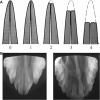Genetic and treatment-related risk factors associated with external apical root resorption (EARR) concurrent with orthodontia
- PMID: 25865535
- PMCID: PMC4810020
- DOI: 10.1111/ocr.12078
Genetic and treatment-related risk factors associated with external apical root resorption (EARR) concurrent with orthodontia
Abstract
Objective: As genetic variation accounts for two-thirds of the variation in external apical root resorption (EARR) concurrent with orthodontic treatment, we analyzed the association of selected genetic and treatment-related factors with EARR concurrent with orthodontic treatment.
Setting and sample population: This case-control study of 134 unrelated, orthodontically treated Caucasian individuals was conducted in part at an Indiana Private Practice, Indiana University and the University of Kentucky.
Methods: Utilizing a research data bank containing information from ~1450 orthodontically treated patients, pre- and post-treatment radiographs from 460 individuals were evaluated for EARR of the four permanent maxillary incisors. Sixty-seven unrelated Caucasians with moderate to severe EARR were identified and were age-/sex-matched with orthodontically treated Caucasian controls yielding 38 females and 29 males per group. Factors tested for an association with EARR included the following: 1) treatment duration, 2) extraction of maxillary premolars, 3) numerous cephalometric measurements, and 4) DNA polymorphisms within/near candidate genes in a pathway previously implicated in EARR such as the purinergic-receptor-P2X, ligand-gated ion channel 7 (P2RX7; rs208294, rs1718119, and rs2230912), caspase-1 (CASP1; rs530537, rs580253, and rs554344), interleukin-1 beta (IL1B; rs1143634), interleukin-1 alpha (IL1A; rs1800587), and interleukin-1 receptor antagonist (IL1RA; rs419598) genes. Stepwise logistic regression was utilized to identify the factors significantly associated (significance taken at or less than the layered Bonferroni correction alpha) with the occurrence of EARR.
Results: A long length of treatment and the presence of specific genotypes for P2RX7 SNP rs208294 were significantly associated with EARR.
Conclusion: EARR occurrence was associated with both genetic and treatment-related variables, which together explained 25% of the total variation associated with EARR in the sample tested.
Keywords: caspase-1; external apical root resorption; interleukin-1; interleukin-1 receptor antagonist; purinergic-receptor-P2X ligand-gated ion channel 7.
© 2015 John Wiley & Sons A/S. Published by John Wiley & Sons Ltd.
Figures




References
-
- Killiany DM. Root resorption caused by orthodontic treatment: an evidence-based review of literature. Semin Orthod. 1999;5:128–33. - PubMed
-
- Remington DN, Joondeph DR, Artun J, Riedel RA, Chapko MK. Long-term evaluation of root resorption occurring during orthodontic treatment. Am J Orthod Dentofacial Orthop. 1989;96:43–6. - PubMed
-
- Weltman B, Vig KW, Fields HW, Shanker S, Kaizar EE. Root resorption associated with orthodontic tooth movement: a systematic review. Am J Orthod Dentofacial Orthop. 2010;137:462–76. discussion 12A. - PubMed
-
- Segal GR, Schiffman PH, Tuncay OC. Meta analysis of the treatment-related factors of external apical root resorption. Orthod Craniofac Res. 2004;7:71–8. - PubMed
-
- Martins DR, Tibola D, Janson G, Maria FR. Effects of intrusion combined with anterior retraction on apical root resorption. Eur J Orthod. 2012;34:170–5. - PubMed
Publication types
MeSH terms
Substances
Grants and funding
LinkOut - more resources
Full Text Sources
Other Literature Sources
Research Materials
Miscellaneous

